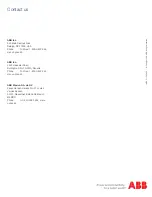
Section 9
DNP3 communication engineering
9.1
Signal configuration user information
Basic knowledge about DNP3 and the used definitions are required to
use CMT. See the DNP3 communication protocol manual for
information on the DNP3 implementation in the IED.
CMT allows to configure the signals that are used to communicate with clients or
master units for DNP3 protocols.
On the left window CMT organizes all available signals from the application
configuration in containers that are preselected as signal types.
On the right window CMT provides containers that are selected by tabs. Each container
represents one communication channel. The number of possible communication
channels is IED type dependent. The IED uses TCP/IP as communication channel.
DNP3 can be tunneled over TCP/IP, and serial communication RS-485 is not
supported.
Use direction icons that are located between the windows to move all signals or a set of
individual signals between the windows.
DNP3 signal types, index and default setting for classes are predefined in CMT. Adapt
the signal configuration to project definitions. The signal type can not be modified due
to the fact that the internal signal set up is fixed.
When the default configuration values are sufficient, the task is finished when all
signal are moved according to the project requirements.
With the
Save
option, the signals are stored for the communication part of the IED
according to the default selections.
Only for analog measurements additional configuration parameters are shown to do
signal scaling to DNP3 protocol presentation. This can be done when the
Configuration Table View
is selected.
Finally, the signal configuration to the different DNP3 channels can be listed in a
report on demand and per signal type.
1MRK 511 245-UUS -
Section 9
DNP3 communication engineering
650 series ANSI
109
Engineering Manual










































